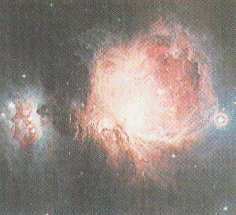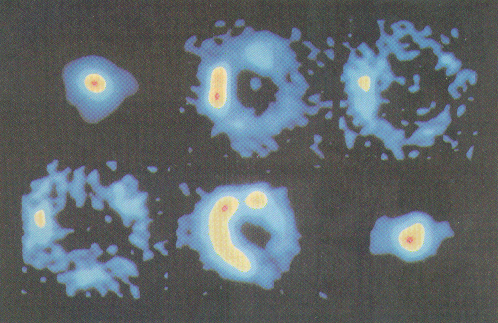

One of the most promising fields of research for the extended MERLIN is the study of the molecules that are found in the gas and dust of interstellar space. like hydrogen atoms, these molecules can be identified by their characteristic spectral lines. Under the right conditions some of these molecules-such as water, hydroxyl and methanol-generate small but intense spots of "stimulated" radio emission known as masers. Masers are found at key stages in the life of a star. When a star is born, masers appear in its enveloping cocoon of dust and gas. The birth-places of the stars are concealed from optical telescopes by the surrounding dust clouds, and masers are one of the few means we have of studying them. |
 The Orion Nebula - a complex of dust and gas in which new stars are being born. (David Malin, copyright TRoyal Observatory, Edinburgh and Anglo-Australian Telescope board). |
When an ageing star runs out of fuel and swells to a red giant,maser spots are seen in its cool outer atmosphere. Red giants blow out several Earth masses of material a year, and maser molecules condense in shells around the star as the cooling gases flow away into space.
In each case astronomers can use the masers to study physical processes that would otherwise be unobservable. MERLIN has already mapped the maser spots around numerous red giants, and the new telescope will allow it to probe star-forming regions anywhere in the Galaxy.
MERLIN has already given us the first images of megamasers, enormously powerful masers found shining from intense star-forming regions in the hearts of distant galaxies. With the new telescope many more of these mysterious objects will be brought within MERLIN's grasp.

Jodrell Bank astronomers used MERLIN to image these successive slices through a shell of hydroxyl maser sources surrounding the dust-shrouded star OH 127.8.